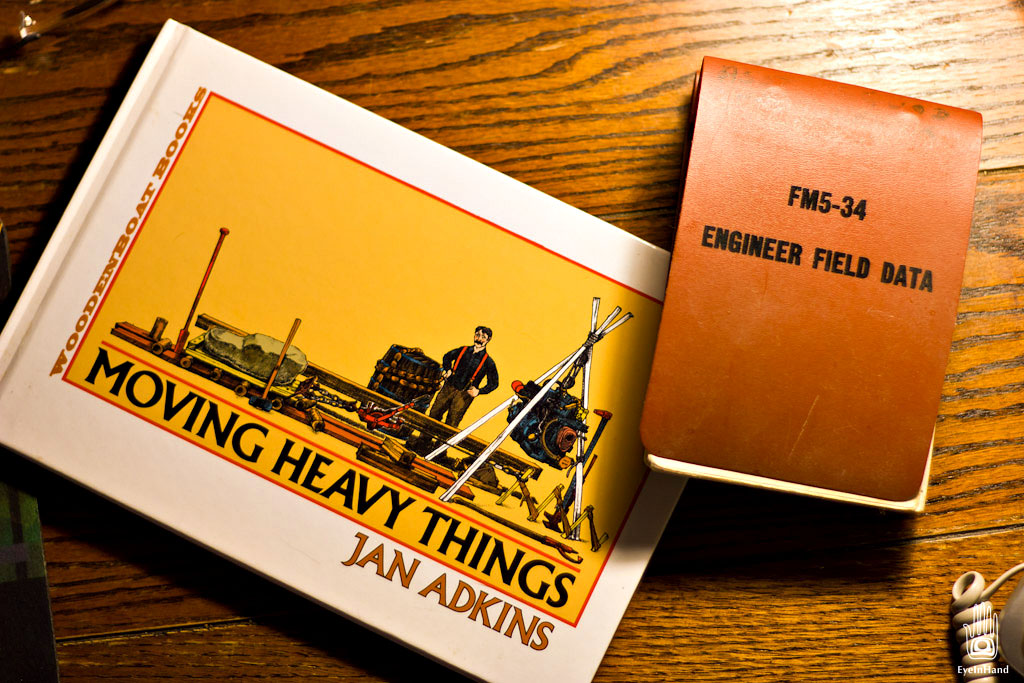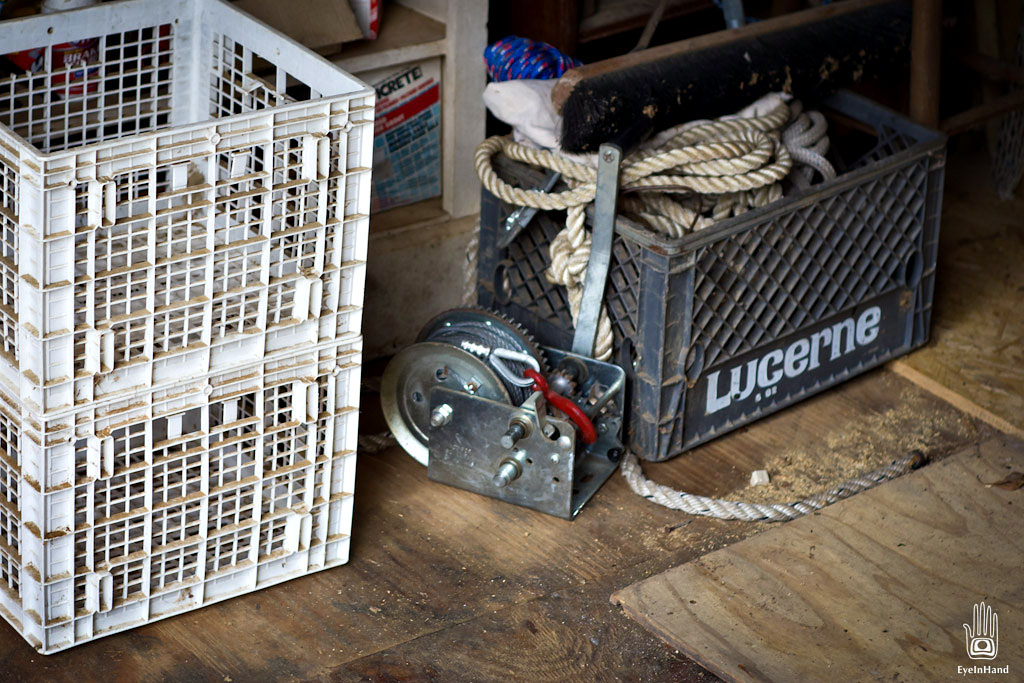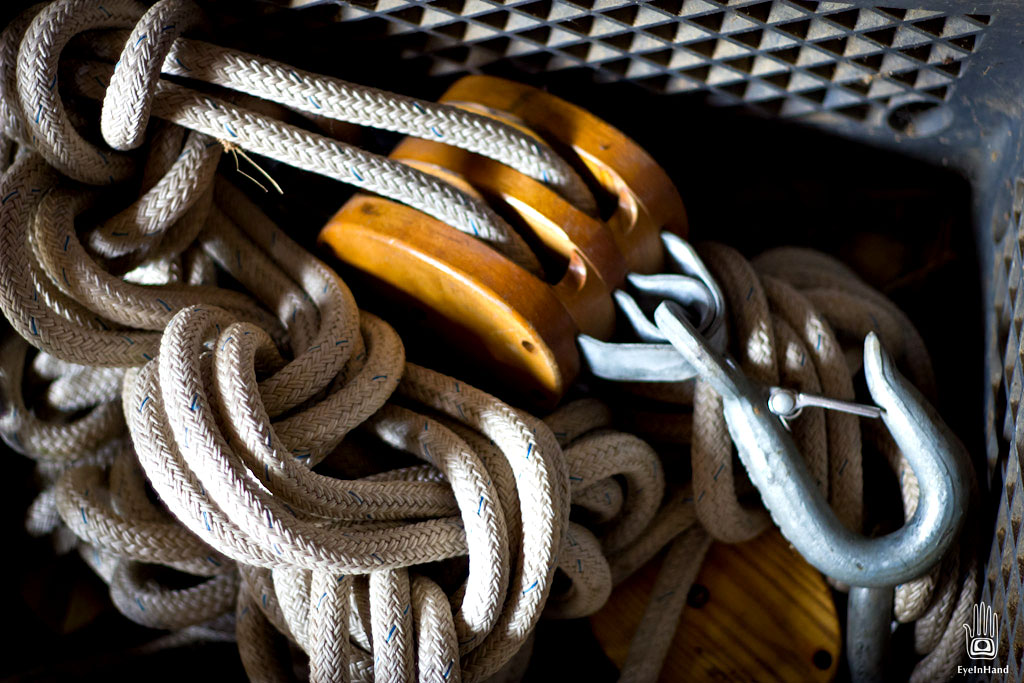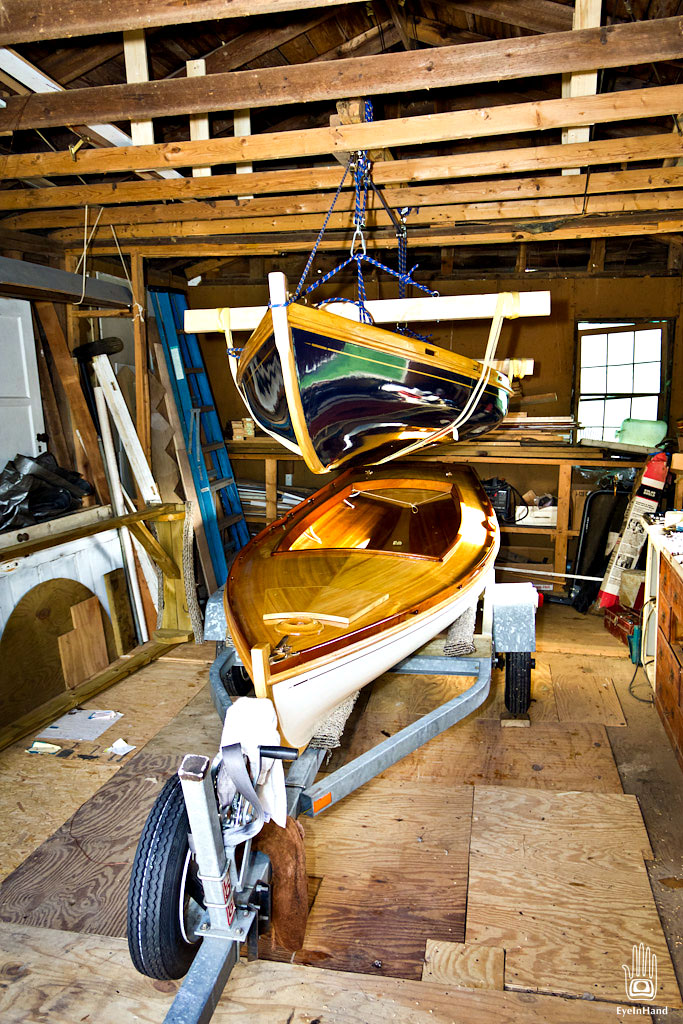Hibernating for the Winter
The hoist took quite a bit of pondering. It needs to be easy to use, but strong enough to hang a boat for months at a time. Old problems tend to have many solutions, and lifting heavy objects is about as old as problems get. Often each method will create a new problem for every one it solves, so settling on the right combination required some thought. It can get complicated. Like friend Steve Early, I confess to a preference for simple tools. Well, in my case, it’s an actual need, a handicap, and I believe I go a bit further than even he does.
Another issue is the old ways of doing things of this sort are all but forgotten. The knowledge is getting fuzzy, even in old timers, and the local hardware stores – which used to serve as impromptu reservoirs of knowledge and the tools to use it – have been replaced by big box home supply stores where you’re lucky if you find any knowledge at all. They would rather sell you a hydraulic lift or electric winch than a good block and tackle, which they won’t even stock.
Fortunately, I still had some tools and know-how left over from an earlier project.
Years ago I started a log cabin way back in the woods. The site was remote, about 3 miles from the nearest power lines. There was no road for the last mile, and I was working alone. The nature of the project necessitated an entirely different way of thinking about all sorts of problems. Modern construction techniques and tools were quite useless there. Suddenly even the most basic task, like moving a 20 foot long log just a few feet, required major feats of engineering. And I needed to move a lot of logs a long way through the woods.
Back in the days before the internet (remember those?) knowledge came in the form of books. I came across two books that were extremely useful, both via tips from friends: Jan Adkins’ Moving Heavy Things, and the Army Corps of Engineers Engineer Field Data pocket reference. Two very different approaches to the same topic, but both quite indespensible.
The Adkins book is a real pleasure. It’s less than 50 pages long and consists almost entirely of elegant hand drawn illustrations, like a kid’s picture book. ‘Nuff said. The “pocket” field guide, on the other hand, is over 400 pages long and contains all sorts of formulas, charts, tables, etc. (no wonder army fatigues have such big pockets); but it has a couple of chapters on simple machines, building bridges and such, that even I can understand. These supplied the know-how.
The best source for the kinds of tools I needed turned out to be a small shop in a former gas station on the edge of town, a no-frills affair that catered specifically to professional loggers and riggers. Though loggers now use bulldozers and other heavy machinery, they still have to work out in the wilderness and still occasionally need tools that haven’t changed in hundreds of years. Alongside two dozen varieties of chain saws, I found heavy duty blocks and rope, nylon slings, cable harnesses, carabiners, peavies, pry bars, hand winches and come-alongs. Come-alongs are annoying to use, in my opinion, but I went home with some of everything else.
From a damaged boat trailer I bought a large hand-winch, spooled with steel cable. Chaining that to a tree, I could run the cable from where the logs were felled, to other trees standing closer to the cabin site. Tightening the cable made a sort of zip line, and I could lift the logs with a block and tackle and roll them down the cable on a pulley with a gentle push, even shooting them across ravines. Pretty slick, though I admit I quickly learned to only fell logs UPHILL from the cabin site. I got so good at this sort of thing my buddies began to refer to me as Barry “Mechanical Advantage” Long.
Today, the lifting tools I can find locally consist of a chain hoist for lifting engine blocks, hydraulic versions of the same, or electric winches. The Boat Shed has no power, anyway, but all of those options require a very strong place to mount whatever it is, because they lift from a single point. Frankly, nothing in this old shed is that strong.
Since I still have most of the gear from the cabin building days, I could experiment a bit. The nylon slings made for big logs work fine for a little boat. My first thought was to use the hand winch and some blocks to supply the lifting power. The problem with that, though, is the winch is so powerful there is no tactile feedback for how much tension is on the cable. I could easily pull down the whole shed without warning. The roof is already sagging. This problem needs an even simpler solution.
So, after tying the ceiling joints into the rafters for extra support, I added a cross bar of sistered 2×4’s. To that is tied a series of blocks, spaced out to disperse the weight, giving an 8:1 advantage.
This worked pretty well. With the added friction in the system, tugging on one end of the rope will lift the whole 200 pound boat in the air with about 30 pounds of pull. I had to play with how the rope weaves through the various blocks, because the boat is lifted from two points, but all the pulling is done from one end, which makes it problematic to apply lift evenly.
My heavy duty logging blocks were overkill for this job, and I still need to use them for other things. So, once the arrangement was set, I had to replace them with the only blocks I can find around here – cheap Chinese junk that doesn’t work very well at all – sharp edges everywhere that catch the rope, poor design, and bad bearings. Too much friction. If I had a bunch of spare sailing blocks they would be perfect, but they’re too expensive for my budget at the moment, and there’s nothing else to be found in between.
The simple one-point sling seemed to put too much side pressure on the hull. It’s likely after a few seasons the hull would get deformed. Adding a spreader for the slings not only removed the pressure, but allowed more clearance to lift the boat higher.
So here you can get an idea of the whole arrangement, and the inside of the “new” shed:
In the Spring I’ll finish work on the double rack for the trailer. I want the boats to be easier to launch and retrieve, which means they both have to ride right side up. There also needs to be a lifting mechanism on the trailer. Fun problems to think through all winter.
Boat lift, Melonseed Skiff













I wouldn’t be a very good friend if I didn’t mention that your shed is drastically under-engineered. (Though you probably know already).
You should sister those collar ties that are holding the weight of the boat, with at least one more 2×4 each. It’s making me nervous.
Michael, I can always count on you to provide the VOD (Voice of Doom). It’s marginal, granted, but not as bad as it looks.
The weight is actually spread across six joists, 2×4’s with a span of less than 6 feet. Each one is supporting roughly 35 pounds. I did some testing first, and individually they will support my weight – roughly 165 pounds – at least briefly. I intend to keep an eye on it in the coming weeks, just the same. Also, you can’t see it in these photos, but the back half of the boat is supported by the old end wall gable of three sistered full size 2×4’s and collars.
Of greater concern is, frankly, the rest of the shed. I don’t know why it’s still standing.
VOD now is it?
Don’t take it personally – it’s a truly valuable service, and most friends don’t have the courage for it.
Well, gravity is a fine thing, but for my money, keeping a roof down is as much of a task as keeping it up, weather being what it is…so I’ll back those boats to help keep the roof on more than I’d worry about them bringing it down since things are sistered and interconnected.
It looks very orderly in there now, with your fine ‘parquet’ floor. Those sure are beautiful hulls.
Sorry, Barry – A lifetime of engineering has made me a gnome. I can actually feel the stress on a board by looking at it, which is usually not very good cocktail conversation.
Rob, I know it’s a sisyphean task, but aren’t humans suppose to defy gravity and entropy? (just an observation, not a philosophy).
MB,
Yeah, well I’ll go down fighting anyway. But I can’t find anyone who’ll put money on me winning….
No problem. Glad to have someone watching out for me. If I hadn’t swung like a monkey from each joist, I’d be more concerned, too. And it is deceiving, hard to remember they’re so much lighter than they look.
A few more collar ties is easy to do and won’t hurt much. Given the hurricanes and tornadoes we’ve had lately, might help hold the roof down (hat tip Rob).
I too am admiring the parquet floor!
So, what ever happened to the cabin?
That floor IS rather interesting, no? All the different shapes and colors. Not unike a calico cat – the one that’s been sleeping in there for months, and scowls at me when I approach, in fact.
Would you believe I only had to make two cuts in the whole thing? Hate doing puzzles, but this was intriguing.
Oh right, the cabin.
That got sidelined by . . . you know . . . life. Now that it’s the third quarter I’ve been thinking it’s time to get it back in the game. A cabin in the woods, a couple of boats at the shore . . . not a bad combination. You have the cabin porn site I sent, so you know what I mean:
http://freecabinporn.com/
Hi Barry,
They look good hanging or swimming! Congratulations, by the way, on the cover of of Ash Breeze! I still hope to get down your way sometime soon. I was also hoping to visit Mike Wick, and see his new ‘seed. Might be time for a field trip.
Jim
Ah, yes, thanks. A very nice photo by Ned Asplundh and his wife. It’s fun to see.
You should definitely come down this way, and bring that beautiful Matinicus with you.
http://sailingskiffs.blogspot.com/
Barry – Your refer to stacking the boats on a trailer. How would the top boat get lauched? Are the boats light enough for two men to carry, or is there a more elegant method that I am not imagining?
Steve in NJ
Hi Steve, sorry, thought I had answered. Yes, they are light enough for two (strong) people to carry, at least short distances. For now they ride deck to deck, clam shell style, in a padded cradle. With the winter over I can finish the trailer project. In the final arrangement, they both ride topside up, with a simple lift so each boat can be loaded and launched single-handed.